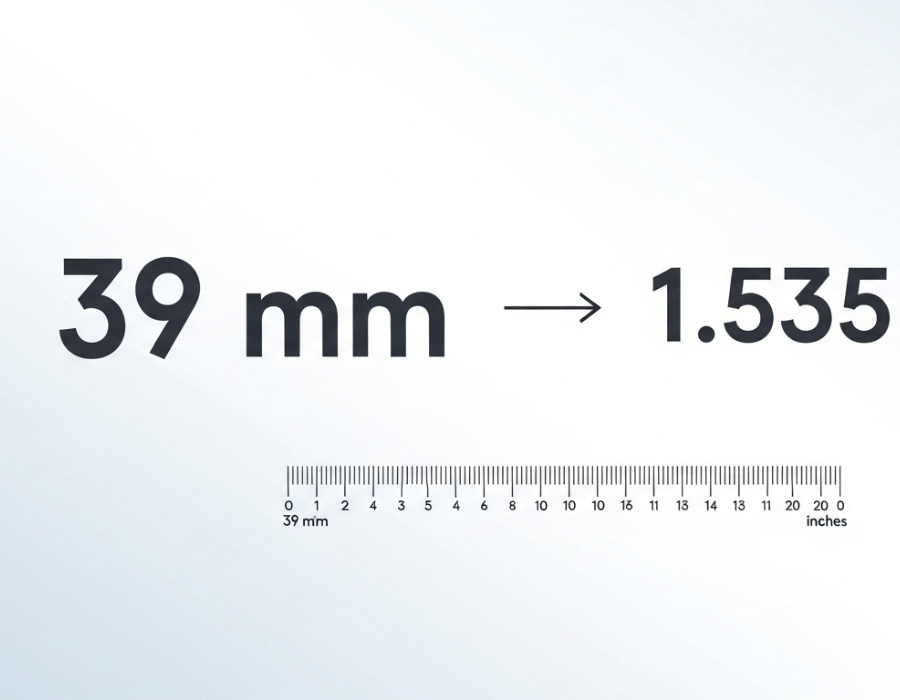Converting millimeters to inches might seem like a small thing, but sometimes the tiniest measurements make the biggest difference. Have you ever bought a watch online, only to realize it looked either too big or too small on your wrist? Or maybe you were shopping for a screw, a socket, or even a camera lens, and the specifications were written in millimeters? That’s exactly where knowing how to convert 39mm to inches can save you from confusion.
In this detailed guide, we’ll explore not just the direct conversion but also the logic behind it, real-life applications, a conversion chart, and answers to all those “People also ask” questions you often see on Google. Let’s dive in.
What is 39mm in Inches?
The most straightforward answer is this:
39 millimeters equals approximately 1.535 inches.
To put it simply, if you line up a ruler with inches on one side and millimeters on the other, 39 millimeters will cross just a little past the 1.5-inch mark.
For a clearer perspective, it’s not quite one and a half inches but just over it—think of a watch dial or a coin that’s slightly bigger than a U.S. half dollar.
The Formula for Converting Millimeters to Inches
Conversions always follow a formula, and this one is super easy to remember:
Inches = Millimeters ÷ 25.4
That’s because 1 inch equals exactly 25.4 millimeters. This standard was agreed upon internationally back in 1959 to make sure all industries—from construction to jewelry—used the same base measurements.
So for 39mm:
39 ÷ 25.4 = 1.535 inches
See? No rocket science needed. It’s just simple math.
Breaking Down the Fractional Form of 39mm
Sometimes decimal numbers aren’t practical, especially in carpentry or DIY projects where tools often use fractions.
-
1.535 inches is approximately 1 17/32 inches.
-
That’s just a hair longer than 1.5 inches.
Think of it like cutting a slice of bread slightly thicker than another—you’d notice the difference if you looked closely, but it’s still small.
39mm in Everyday Life: How Big Is It Really?
Numbers can feel abstract, so let’s compare 39mm to items you might recognize:
-
Watch dial: A 39mm watch case is considered a perfect “classic size” for men’s wrists and also unisex-friendly.
-
Coin size: It’s slightly larger than a U.S. half dollar, which measures about 30.6mm.
-
Screw or socket: In hardware, a 39mm socket is a mid-range size often used in automotive work.
-
Jewelry: A pendant or ring with a 39mm design would appear bold but not oversized.
So if you’ve ever struggled to imagine the size, just think: “about the width of a medium-sized cookie.”
Conversion Chart: Millimeters to Inches (30mm–50mm)
Instead of doing math each time, it helps to look at a ready-made chart. Here’s a quick reference:
| Millimeters (mm) | Inches (in) |
|---|---|
| 30 mm | 1.181 in |
| 35 mm | 1.378 in |
| 39 mm | 1.535 in |
| 40 mm | 1.575 in |
| 45 mm | 1.772 in |
| 50 mm | 1.969 in |
From this table, you can see how 39mm sits neatly between 35mm and 40mm, closer to the latter.
Related Conversions You Might Need
Since people searching for 39mm to inches often check nearby sizes too, let’s quickly cover them:
-
38mm = 1.496 inches (almost exactly 1.5 inches)
-
39.5mm = 1.555 inches (slightly more than 39mm)
-
40mm = 1.575 inches (just a touch bigger than 1.5 inches)
If you’re comparing watch sizes or screws, these differences may seem tiny—but they can impact fit and appearance.
Why Do We Use Millimeters and Inches?
This question comes up a lot: why do we even bother with two systems?
-
Millimeters (mm) belong to the metric system, used in most countries worldwide. It’s simple because everything is based on powers of ten.
-
Inches (in) are part of the imperial system, still popular in the United States and sometimes the UK.
So when you’re reading a global product description, you often see both units listed. Imagine buying shoes where one country lists sizes as “7” and another as “40”—that’s the same idea with mm and inches.
Tools and Methods to Convert Instantly
While the formula is easy, you don’t always want to pull out a calculator. Thankfully, you have options:
-
Online unit converters: Websites like ConvertUnits or InchCalculator give instant answers.
-
Smartphone apps: Free apps let you plug in values quickly.
-
Google search: Just type “39mm to inches” into Google, and it gives the answer at the top.
-
Printed charts: Still useful for workshops, carpentry, or sewing.
It’s like having a translator in your pocket—only instead of languages, it’s units of measurement.
Practical Uses of Knowing 39mm to Inches
You may be wondering: when will I actually need this? Here are some scenarios:
-
Fashion & watches: Deciding whether a 39mm watch suits your wrist.
-
DIY projects: Measuring screws, nails, or pipes listed in millimeters.
-
Automotive work: Tools, bolts, and sockets often come in metric sizes.
-
Crafts & jewelry: Small components are usually measured in mm.
-
Cameras & lenses: Photography gear is often listed in mm, like a 39mm filter thread.
In all these cases, having a mental picture of 39mm in inches gives you an instant advantage.
Common Mistakes in Conversion
People often make small but important errors:
-
Rounding too much: Saying 39mm is “just 1.5 inches” might seem fine, but the extra 0.035 inches can matter in precise work.
-
Mixing cm with mm: 39mm is not the same as 39cm. In fact, 39cm equals about 15.35 inches.
-
Not checking the context: A screw size of 39mm and a watch dial of 39mm may look very different in use.
It’s like cooking—if a recipe calls for 1.5 teaspoons and you just “eyeball” it, you might throw off the taste. Precision matters.
Quick Recap
Let’s tie everything together:
-
39mm = 1.535 inches
-
Use the formula: mm ÷ 25.4
-
In fractions: about 1 17/32 inches
-
Think of it as the size of a medium watch dial or small cookie
-
Use charts, apps, or calculators for convenience
-
Remember: even tiny differences matter in the right context
Conclusion
At first glance, converting 39mm to inches may feel like a small detail, but it’s often these small details that make big differences in our daily lives. Whether you’re buying a watch, fixing your car, sewing a dress, or working on a craft project, knowing how to convert units gives you confidence and clarity.
The next time you see 39mm written somewhere, you won’t have to wonder—you’ll know it’s about one and a half inches. A little knowledge goes a long way.
FAQs
What is 39mm in inches?
39mm equals about 1.535 inches, which is a little more than 1.5 inches.
Is 40mm exactly 1 inch?
No, 40mm is about 1.575 inches. One inch equals 25.4mm, so 40mm is larger than an inch.
What is 39cm in inches?
39 centimeters equals about 15.35 inches, which is much bigger than 39mm.
How many inches is 38mm?
38mm equals about 1.496 inches, which is almost exactly 1.5 inches.
Why is it important to know mm to inches conversions?
Because different countries and industries use different systems. Knowing both helps in shopping, DIY projects, and technical tasks.



